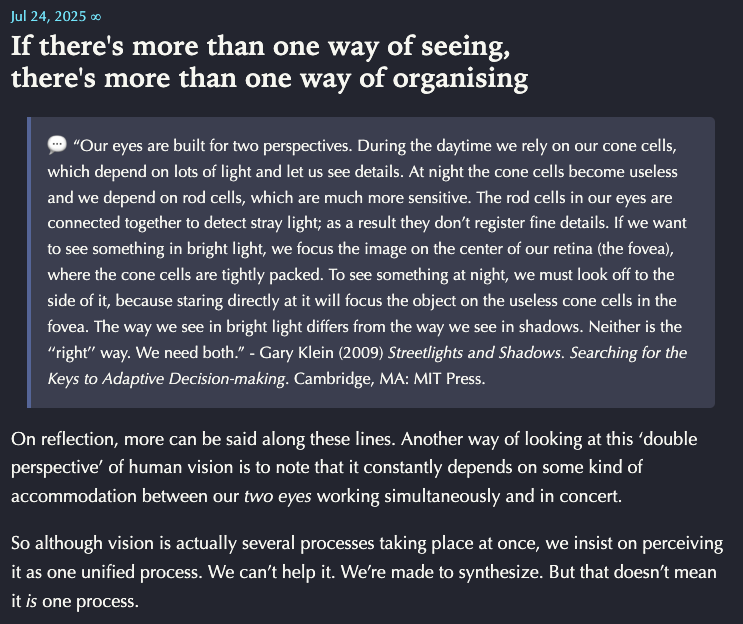Watch in awe as a fleeting thought becomes a lasting note
I’ve been asked a great question about my writing process:
Curious to know, is this post, and other short ones like it, basically repurposed main notes from your zettelkasten? And, if so, care to show an example of “before and after?”
Tldr; No.
To be honest, this question put me on the spot. I often write posts on the run, and the post in question was no exception. I couldn’t think where the quote at the top of the post had come from. It isn’t in my Zettelkasten, my collection of working notes. But then I also keep a big swipe file of tasty quotes (collector’s fallacy is real!)… and when I looked, it wasn’t in there either.
But then I remembered: I have several writing projects on the go at one time, and I’d been reading through an old manuscript that I haven’t touched for some time. As I did so, this particular quote stood out for me. It inspired a new thought and so the writing of this short post was effectively me writing a new Zettelkasten post on the fly. How so?

See what I did here?
- First, I recorded the quote that attracted me, giving the full reference so it can be re-found later. I was inspired by the idea that our supposedly singular vision is actually two separate processes, rods and cones, working in unison.
- Next, I made this my own by recording my own reflection: even more striking, we have two separate eyes, yet still see only one image.
- Third, I added a meaningful title: If there’s more than one way of seeing, there’s more than one way of organising. This small point about how vision works could be a metaphor for social and political organisation - that’s what I started to think. What may look like one unified effort is very often the combined result of many adjacent processes working together to create the effect of unified action. And if this is the case, then there’s surely more than one way of doing it. I didn’t elaborate, since, as I said, I wrote this on the run. But what’s implied by the post’s title gives me a jumping off point for future notes (like this one).
The bit where you say: So what?
Maybe I’m overstating things, but then maybe this short post is a model of how I approach writing notes in my Zettelkasten:
- First, it shows that you can write a fleeting note anywhere - even on your website if you like (don’t tell me you haven’t got one - it’s the hottest new trend, I’ve heard). And it’s just one idea, which means it’s the shortest writing session that could possibly be useful. So I’ve now transferred this post to my Zettelkasten, where it will combine and recombine for future use.
- Second it shows how from fragments you can build a greater whole. That’s how I usually write posts, especially the longer ones. But even just a single quote plus a single thought, as here, can add up to a simple post.
- Next, it shows how it’s valuable to add something of your own, rather than just collecting random quotes without commentary. Remember: nothing says “I didn’t think this through for myself” like a direct quote.
- Fourth, it demonstrates the value of a strong title. In this case, the title is doing a lot of the lifting, since…
- Fifth, I posted this online before I’d even finished the note, which means it exemplifies the maxim, publish first, write later.
Now what the post failed to demonstrate is the great value of links to other ideas. After all, a linked note is a happy note. So to atone for this gross omission, I’m doing it now. And just look at all those links!
Make the most of your note
This whole exercise, of working and reworking notes, is strongly inspired by a great line in Bob Doto’s book, A System for Writing:
“The note you just made has yet to realize its potential.”
I just love this saying. And I’ve written in more detail about this exact process, in How to write a better note without melting your brain. In that article I go through a worked example of how to turn a crappy note into a useful note. But unlike me you’ve probably never written a crappy note, so don’t bother reading it.
——
Thanks for reading this crappy note. You might like to sign up to the weekly email digest, for all the week’s Writing Slowly fragments, presented in a (slightly) greater whole.
And look out for my new book, Shu Ha Ri: The Japanese Way of Learning, for Artists and Fighters.